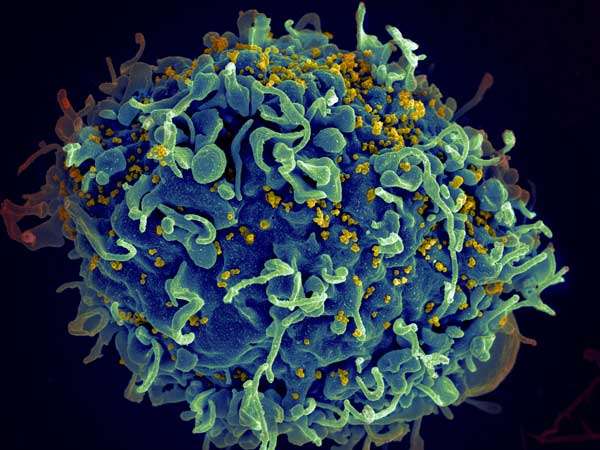Scientists uncover how part of a protein helps primates fight HIV

Scientists have uncovered part of a protein found in humans and other primates that can help us fight off HIV. In a new study published in the journal Heliyon, researchers discover how this structure can stop HIV from working and switch on our immune system at the same time. The findings, say the authors of the study, could potentially be used in developing anti-HIV gene therapy in the future.
All primates - including humans - have a protein called TRIM5alpha. This protein can intercept HIV and related viruses and stop them from replicating and infecting more cells. It can also switch on the immune system, helping us fight HIV infection. Scientists have previously identified different parts of the TRIM5alpha protein that are responsible for the protein's ability to fight HIV.
The researchers behind the new study believe the protein switches on the immune system by attaching to another protein called "SUMO." However, two of the structures that could potentially attach to SUMO proteins are hidden inside TRIM5alpha, making it impossible for them to attach.
In the new study, researchers from Université du Québec à Trois-Rivières in Canada, the University of Colorado Boulder, and Albert Einstein College of Medicine in the United States have identified a new part of the TRIM5alpha protein that could attach to SUMO and thereby activate an immune response. They call it SIM4, or "SUMO interacting motif 4".
"HIV-1 inhibition by restriction factors is fascinating as a natural antiviral system," said Dr. Berthoux, corresponding author of the study from Université du Québec à Trois-Rivières. "Our new findings contribute to mapping how our immune systems are activated against retroviruses like HIV."
Dr. Berthoux and the team analyzed SIM4 to see if it does indeed have an effect on how we fight HIV. They found that when SIM4 is mutated, the TRIM5alpha protein can no longer attach to HIV or stop it from working. This finding suggests that SIM4 is vital for arming TRIM5alpha against HIV.
TRIM5alpha can be used in gene therapy to treating HIV infection. With this approach, the immune system could be activated, causing unwanted side effects. According to the researchers, using genes with mutations that stop this activation could be one way to optimize gene therapy.
"Our cells can mount a surprisingly complex response to viral infections," added Dr. Berthoux. "Finding a way to tweak the activity of these antiviral factors so that they target HIV, or other viruses of interest, is a valuable avenue of research."
More information: "A putative SUMO interacting motif in the B30.2/SPRY domain of rhesus macaque TRIM5α important for NF-κB/AP-1 signaling and HIV-1 restriction" by Marie-Édith Nepveu-Traversy et al. (www.heliyon.com/article/e00056/ ). The article appears in Heliyon (January 2016) dx.doi.org/10.1016/j.heliyon.2015.e00056



















